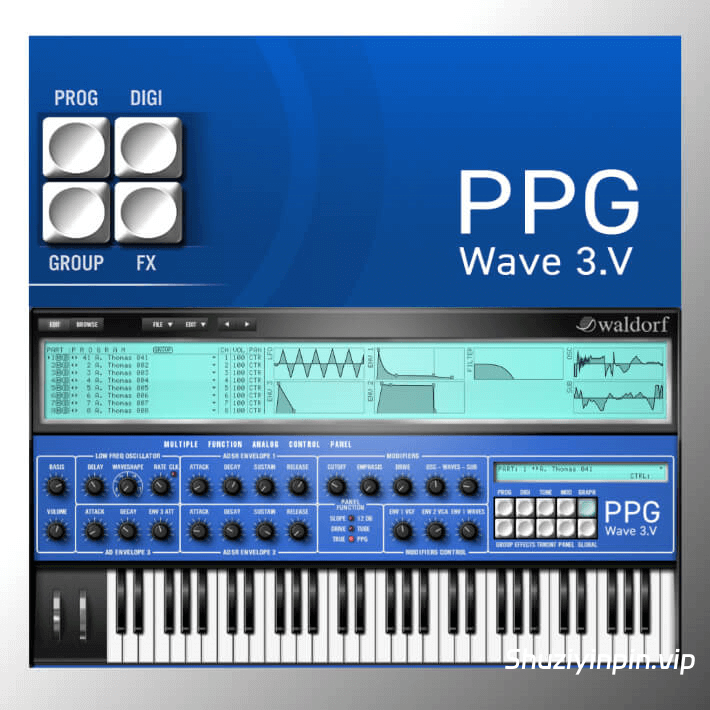关联资源
[波表合成器] Waldorf PPG Wave 3 V v1.3.2 Incl Keygen-R2R [WiN, MacOSX]

TCD | 04 September 2025 | 36.62 MB
安装方法:只需安装,尽情享受!
Waldorf PPG Wave 3.V 是传奇的 PPG 波形合成器的再造,毫无疑问,它被认为是 80 年代最受推崇的高端合成器之一。这款合成器由 Wolfgang Palm 开发,出现在无数唱片中,激励了整整一代制作人、作曲家和听众。在那个年代,您可以选择是买车还是买 PPG,而全新的 PPG Wave 3.V 以非常实惠的价格呈现了这一令人惊叹的声音特性,并且可以轻松地用于每个 VST 或 AU 主机。
PPG Wave 2 是第一款带有模拟滤波器的数字波表合成器,可实现全新的声音世界和无限的声音可能性。不久之后,继任者 PPG Wave 2.2 问世,诞生创造历史。凭借庞大的波形库,它不仅可以再现已知的模拟声音,还可以再现出色的合唱团、花里胡哨。波表的数字声音在此之前是闻所未闻的,并通过平稳地来回穿越 64 个波浪,提供了耸人听闻的声音演变。
但技术的可能性也产生了刺耳的伪影,例如锯齿等,这在当时是不能省略的。今天,尽管技术更进一步,但华德福工程师甚至设法恢复了刺耳,以重现野兽的性格。
波表合成的发明者Wolfgang Palm在开发过程中提供了帮助,以尽可能接近地重新创建PPG。“我们非常感谢Wolfgang在开发过程中提供的信息丰富的建议和见解。”华德福开发人员Stefan Stenzel说。
PPG的数字波形和模拟滤波器的结合创造了无与伦比的增压和推力增强特性。PPG 3.v在PPG 3.v中非常精确地再现了这一点,直到最小的细节分辨率。使用PPG 3.V,实际上可以在原始版本的多个版本之间切换。除了PPG Wave 2.2和PPG Wave 2.3之外,PPG Wave 2.V及其在混叠和其他粗糙度源方面的细微差异也是可调的。
华德福 PPG Wave 3.V 能够提供多达 256 种复音声部,具体取决于主机。每个声部提供两个波表振荡器,可选择以 8、12 或 32 位分辨率播放样本。样本可以通过拖放轻松加载。8 声部多模式允许多样本以与原始版本相同的魅力和易用性使用。
声音由可选的 12 或 24 dB 低通滤波器进一步塑造,这是经典 PPG Wave 2.2/2.3 滤波器的真实再现,然后是可选的过载以获得额外的模糊。除了 LFO 之外,三个包络发生器还用作调制源,用于原始粗鲁或现代平滑调制。
多达八个声部可以以多音、双音、四和单声道同音模式排列,并可单独调整自动和弦或旋律的半音。由于具有八个立体声输出的多模式,该乐器非常适合录音室环境或舞台现场表演。
琶音器提供向上和向下模式,除此之外还有一种替代模式,“级联模式”是 PPG 真正的特色。为了进一步完善,可以同时使用多种效果器,其中包括 4 频段均衡器、多种过载模式、具有多达 12 个阶段的移相器和具有多达 6 个敲击的合唱。还提供镶边、立体声延迟和混响。
最初的 PPG 具有独特的用户界面,“模拟控制面板”提供了对许多参数的直接访问,而数字菜单则使用有些神秘的首字母缩略词进行编辑,您必须在膝盖上的手册中查找这些首字母缩略词。
PPG Wave 3.V具有完全相同的概念,但略微增强了可理解的参数名称和值。几乎所有参数都可以通过分配的控制编号进行主机自动化和方便的MIDI调节。这使得将PPG Wave 3.V集成到任何现有的制作环境中变得非常容易。
常规
每个实例最多 256 个声音(取决于可用的 CPU 功率)
8 部分 多模
8 立体声输出 大多数参数
的
主机自动化 大多数参数
的 MIDI 控制器自动化 Wolfgang Palm
创建的 100 多个新波表 Waveterm B Factory 样本库
PPG Wave Factory 原声
每个声音
2 个波表振荡器
8 位、12 位或高达 32 位
的样本播放 PPG Wave 2.2/2.3/2.V 的真实混叠仿真或无混叠
12dB / 24 dB 低通滤波器
PPG Wave 的真实滤波器仿真 2.2/2.3 滤波器
后面的
过载 1 低频振荡器
3 包络
调制颗粒度的真实仿真(可通过 True PPG 切换)
每个声部(最多提供 8 个声部)
多声部、双声道、四声道和单声道(8 个声部)模式,具有 8 个不同的半音偏移量,可创建和弦或旋律线
具有上、下、交替和级联(PPG 特殊)模式
的琶音器 真正的 PPG 模式可在 PPG Wave 2.2、Wave 2.3 和 Wave 2.V
之间切换 具有各种类型的
4 频段均衡器
过载 具有多达 12 级的移相器 具有多达 6 级的
合唱
镶边立
体声延迟
混响
其他功能
通过拖放或加载文件对话框加载样本 使用 8 部分多模
8 可调截止/共振偏差来模拟模拟不精确性
进行
多样本播放 在精细调制模式下对多个值进行更精细的调整
x64:AAX、VST3、VST2 |x86:JBridge
只需安装即可。
-TCD
Waldorf PPG Wave 3.V is the reincarnation of the legendary PPG Wave Synthesizer, which no doubt is considered one of the most respected high-end synthesizers of the 80s. Developed by Wolfgang Palm, this instrument is featured on countless records, and it inspired a whole generation of producers, composers and listeners. While back then it was your choice to spent your money either for a vehicle or the PPG, the new PPG Wave 3.V renders this breathtaking sonic character very affordable, comfortably to use for every VST or AU Host.
PPG Wave 2 was the very first digital Wavetable synthesizer with analog filters that allowed completely new worlds of sound and endless sonic possibilities. Shortly afterwards, the successor PPG Wave 2.2 came out and was born to make history. With a gigantic arsenal of waveshapes, it could not only reproduce known analog sounds, but also brilliant choirs, bells and whistles. The digital sounds of wavetables had been unheard until then and offered sensational sonic evolutions by smoothly going through 64 waves back and forth.
But the technical possibilities also produced harsh artifacts such as aliasing and others, which could not be omitted back then. Today, although technology is some steps further, Waldorf engineers even managed to get the harshness back in order to recreate the character of the beast.
Wolfgang Palm, the inventor of Wavetable Synthesis, assisted during the development process in order to recreate the PPG as close as possible. “We are very thankful for Wolfgang’s very informative advice and insight during development.” Says Waldorf developer Stefan Stenzel.
The combination of digital waveshapes and analog filters of the PPG was responsible for an unparalleled fat and thrust boosting character. This has been very accurately recreated in PPG 3.v up to the smallest resolution of detail. With PPG 3.V, it is actually possible to switch between several version of the original. Besides PPG Wave 2.2 and PPG Wave 2.3, PPG Wave 2.V and their subtle differences in aliasing and other sources of harshness are adjustable.
Waldorf PPG Wave 3.V is capable of delivering up to 256 voices of polyphony, depending on the host computer. Each voice offers two Wavetable oscillators with optional sample playback with either 8, 12, or 32 bits of resolution. Samples can easily be loaded by Drag & Drop. An 8 part multimode allows multisamples to be used with the same charme and ease of use that the original offered.
Sound is further shaped by a selectable 12 or 24 dB lowpass filter, which is an authentic recreation of the classic PPG Wave 2.2/2.3 Filter, followed by an optional overdrive for extra fuzz. Besides the LFO, three envelope generators serve as modulation sources, either for the original rude or the contemporary smooth modulation.
Up to eight parts can be arranged in poly, dual, quad and mono unison modes, with separate semitone adjustments for automatic chords or melodies. Thanks to the multimode with eight stereo outputs, the instrument is well suited for both studio environment or live on stage.
The Arpeggiator offers up and down modes, besides this an alternate mode and with “cascade mode” a true PPG specialty. For further refinement, several effects are available simultaneously, among these a 4-band equalizer, several overdrive modes, a phaser with up to 12 stages and a chorus with up to six taps. Flanger, stereo delay and reverb are also available.
The original PPG featured a unique user-interface, the “Analog Control Panel” offered direct access to many parameters, while digital menus were edited with somewhat cryptic acronyms that you had to look up in the manual in your lap.
PPG Wave 3.V features the very same concept, with the slight enhancement of comprehensible parameter names and values. Almost all parameters can be subjected to host automation and convenient MIDI regulation by assigned control numbers. This makes it very easy to integrate PPG Wave 3.V into any existing production environment.
General
Up to 256 voices per instance (depending on available CPU power)
8 part Multimode
8 Stereo Outputs
Host automation of most parameters
MIDI Controller automation of most parameters
More than 100 new Wavetables created by Wolfgang Palm
Original Waveterm B Factory Sample Library
Original PPG Wave Factory Sounds
Per Voice
2 Wavetable Oscillators
Sample Playback with 8 bit, 12 bit or up to 32 bit
Authentic Aliasing Emulation of the PPG Wave 2.2/2.3/2.V or no aliasing
12dB / 24 dB Low Pass Filter
Authentic Filter Emulation of the PPG Wave 2.2/2.3
Overdrive behind Filter
1 LFO
3 Envelopes
Authentic Emulation of the modulation graininess (switchable with True PPG)
Per Part (up to 8 parts available)
Poly, Dual, Quad and Mono (8 voices) mode with 8 different semitone offsets to create chords or melodic lines
Arpeggiator with Up, Down, Alternate and Cascade (PPG special) mode
True PPG Mode switchable between PPG Wave 2.2, Wave 2.3 and Wave 2.V
4-Band EQ
Overdrive with various types
Phaser with up to 12 stages
Chorus with up to 6 stages
Flanger
Stereo Delay
Reverb
Other Features
Sample loading via drag&drop or load file dialog
Multisample playback by using the 8 part Multimode
8 adjustable Cutoff / Resonance deviations to simulate analog inexactness
Finer adjustments of several values in Fine Modulatione mode
x64: AAX, VST3, VST2 | x86: JBridge
Just install.
-TCD
TCD

![[DJ采样器工具] Serato Sample v2.2.0-V.R [WiN, MacOSX](320MB)](https://www.shuziyinpin.vip/wp-content/uploads/2025/11/Serato-Sample-v2.1.0.png)
![[更新:康泰克采样器] Native Instruments Kontakt 8 v8.8.0-bobdule [WiN](1.2GB+)](https://www.shuziyinpin.vip/wp-content/uploads/2025/04/24bdef738a16963d55ad7780e2f1633e-1024x1024.jpeg)
![[实时音高转换插件] zplane elastiquePitch V2.5.0-V.R [MacOSX](16.82MB)](https://www.shuziyinpin.vip/wp-content/uploads/2025/12/04122590_zplane-elastiquepitch-v2.5.0.png)
![[新增IRC 5:臭氧母带处理插件] iZotope Ozone 12 Advanced v12.1.0 [WiN](498.7MB+503.6MB)](https://www.shuziyinpin.vip/wp-content/uploads/2025/09/Ozone-12-v12.0.2.png)
![[超级鼓手] Toontrack Superior Drummer v3.4.2 Update-V.R [WiN,MacOSX](600MB+510MB)](https://www.shuziyinpin.vip/wp-content/uploads/2025/05/1506363736_toontrack-superior-drummer-3.png)
![[专业的峰值和响度计量插件] zplane PPMulator3 XL v3.6.7-V.R [WiN, MacOSX](9MB+25MB)](https://www.shuziyinpin.vip/wp-content/uploads/2025/12/04122531_zplane-ppmulator3-xl.png)

评论0